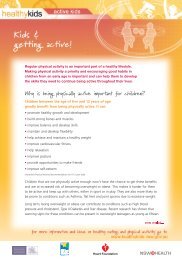I Move We Move - Good For Kids - NSW Government
I Move We Move - Good For Kids - NSW Government
I Move We Move - Good For Kids - NSW Government
You also want an ePaper? Increase the reach of your titles
YUMPU automatically turns print PDFs into web optimized ePapers that Google loves.
2.3<br />
Curriculum, teaching and learning experiences<br />
Physical activity in early childhood is important as it provides an ideal opportunity to set a strong<br />
foundation for active habits into adolescence and adulthood and also develop lifelong skills.<br />
Children's Services can maximise opportunities for children to be active through incorporation of<br />
physical activities into the curriculum, active play and learning experiences. The learning experiences<br />
should be integrated throughout the day. They can also provide opportunities for developing other<br />
skills in the following key areas:<br />
• Physical development (sensory, fine and gross motor skills)<br />
• Social development (interacting with adults and other children, ability to work as part of a team<br />
and controlling behaviour)<br />
• Science and mathematics (the environment, gardening, counting and numbers)<br />
• Language and communication (listening, talking, reading, using pictures)<br />
• Art and creativity (painting, dramatic play, dance)<br />
<strong>For</strong> example, to link stability skills learning experiences<br />
to other areas of the curriculum you could ask preschoolers<br />
to think of what their body looks like when they stretch,<br />
bend, twist or balance then demonstrate and draw it.<br />
The drawings could then be made into prompt cards<br />
for these activities. Your children may like to create<br />
their own set of cards using their ideas.<br />
The integration of physical activity learning experiences throughout the day should involve:<br />
• Opportunistic learning<br />
• Programmed learning experiences<br />
• Linking the learning experiences with the home<br />
The promotion of healthy physical activity habits is part of the National Childcare Accreditation<br />
Council’s Quality Improvement and Accreditation System. By providing learning experiences that<br />
encourage physical activity, accreditation requirements will also be met 13 .<br />
Learning experiences should be based on children’s individual interests, their age, their prior<br />
knowledge and include the basic principles of each fundamental movement skill for the particular<br />
age group. The I <strong>Move</strong> <strong>We</strong> <strong>Move</strong> Physical Activity Handbooks provide examples of learning experiences<br />
for physical activity and small screen recreation to integrate into your service’s everyday programs<br />
and practices. It also provides ideas to develop additional learning experiences. These experiences<br />
can be adapted and extended as required to better suit individual children and services.<br />
I <strong>Move</strong> <strong>We</strong> <strong>Move</strong>, The Guide Edition 1 August 2009<br />
Legs apart, arm<br />
stretched up to<br />
the sky<br />
AREA HEALTH SERVICE




